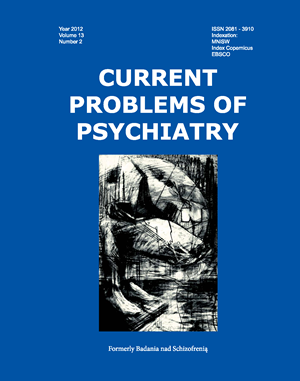Posttraumatic stress disorder – history, terminology, measurement methods
Keywords:
posttraumatic stress disorder, historical background, diagnostic criteriaAbstract
Zespół stresu pourazowego – PTSD (ang. posttraumatic stress disorder) jest zaburzeniem lękowym występującym u osób narażonych na zdarzenie traumatyczne. Obraz PTSD zależy od wielu czynników pretraumatycznych, rodzaju działającego czynnika, a także od okoliczności występujących po ekspozycji takich jak wsparcie czy pomoc specjalistyczna. Mimo, że pojęcie zespołu stresu pourazowego wprowadzono do kategorii diagnostycznych w latach osiemdziesiątych, sama obecność tego zaburzenia towarzyszyła ludzkości od jej początku. Znalazło to swoje odbicie w literaturze, a także w obserwacjach medycznych. Przez lata zmieniało się rozumienie i postrzeganie PTSD, co powodowało ewolucję definicji zaburzenia po stresie traumatycznym. Miało to swój wyraz w stosowanych powszechnie klasyfikacjach diagnostycznych ICD czy DSM.
Procesowi temu towarzyszyło rozwijanie narzędzi pomiaru przydatnych w diagnozie jak i pozwalających na dalsze badania. Różnorodność opracowanych dotychczas metod, pozwala na coraz bardziej obiektywne i dokładne diagnozowanie zaburzenia.
References
1. Stępień M. Ensi w czasach III dynastii z Ur: aspekty ekonomiczne i administracyjne pozycji namiestnika w świetle archiwum z Ummy. Warszawa; UWaL: 2006.
2. Ben-Ezra M. Trauma 4000 Years Ago?. Am J Psychiatry, 2002; 159: 1437-1437.
3. Shay J. Learning about combat stress from Homer's Iliad. J Trauma Stress, 1991; 4: 561-582.
4. Shay J. Odysseus in America: Combat Trauma and the Trials of Homecoming. New York; Sribner: 2002.
5. Dudek B. Zaburzenia Po Stresie Traumatycznym. Gdańsk; Gdańskie Wydawnictwo Psychologiczne: 2003.
6. Heitzman J. Psychiatryczna diagnoza zespołów pourazowych – klinika, orzecznictwo. Psychiatria w Praktyce Ogólnolekarskiej; Via Medica, 2002; 1 2.
7. Black D. Psychological trauma: a developmental approach. London; Gaskell: 1997.
8. Hovens J.E. Research into the psychodiagnostics of posttraumatic stress disorder. J Trauma Stress., 1996; 9(2): 399-400.
9. Friedman M.J., Terence M., Resick P.A. Handbook of PTSD: Science and Practice. New York; Guilford Pubn: 2010.
10. Erichsen J.E. On Railway and Other Injuries of the Nervous System. Philadelphia; Henry C. Lea 1867.
11. Van der Kolk B.A., Brown P., Hart O.P. Janet on post-traumatic stress. J Trauma Stress, (2-4) 1989; 365-378.
12. Wilson J.P. The Historical Evolution of PTSD Diagnostic Criteria: From Freud to DSM-IV. J Trauma Stress, 7,(4), 1994.
13. Orwid M. Krakowskie badania nad PTSD. Dialog.11, Mit i tabu, 2002.
14. Heitzman J. Psychiatryczna diagnoza zespołów pourazowych – klinika, orzecznictwo. Psychiatria w Praktyce Ogólnolekarskiej. 2002; 2:21-38.
15. Heitzman J. Reakcja na ciężki stres i zaburzenia adaptacyjne W., Pużyński S., Rybakowski J.,Wciórka J. Psychiatria, T. 2, Wrocław;Urban & Partner: 2011; 428-452.
16. International Classification of Diseases, Revision 6 http://www.wolfbane.com/icd/icd6h.htm. 1.03.2012
17. International Classification of Diseases, Revision 8 http://www.wolfbane.com/icd/icd8h.htm. 1.03.2012
18. ICD-10.Klasyfikacja zaburzeń psychicznych i zaburzeń zachowania w ICD 10. Badawcze kryteria diagnostyczne. Kraków-Warszawa; Vesalius Instytut Psychiatrii i Neurologii: 1998.
19. American Psychiatic Association .Diagnostic and statistical manual of mental disorders.Txt Revision.4th ed.Washington 2000.
20. Diagnostic and Statistical Manual of Mental Disorders (DSM-5) http://www.dsm5.org/ProposedRevision. 1.03.2012
21. Rosen G.M., Lilienfeld S.O., Frueh B.C., McHugh P.R., Spitzer R.L. Reflections on PTSD’s future in DSM-V. The British Journal of Psychiatry, 2010; 197: 343-344.
22. Hovens J.E. Research into the Psychodiagnosics of Postttraumatic Sress Disorder. Delft; Eburon Press: 1994.
23. Newman E., Kaloupek D., Keane T. Assessment of posttraumatic stress disorder in clinical and research settings.van der Kolk B.A., McFarlane A C., Weisaeth L. W: Traumatic stress: The effects of overwhelming experience on mind, body, and society. New York; Guilford Press:1996: 242-275.
24. Robins L.N., Helzer J.E., Croughan J.L., Ratcliff K.S., National Institute of Mental Health Diagnostic Interview Schedule: its history, characteristics and validity. Arch Gen Psychiatry, 1981; 38(4): 381-389.
25. First M.B., SpitzerR.L., Gibbon M., Williams J.B.W. The Structured Clinical Interview for DSM-III-R Personality Disorders (SCID-II). Part I: Description. J Personal Disord., 1995;(9),(2): 83-91.
26. Davidson, J.R.T., Kudler H.S., Smith R.D. Assessment and pharmacotherapy of posttraumatic stress disorder. W: Giller J.E.L. Biological assessment and treatment of posttraumatic stress disorder. Washington DC; American Psychiatric Press: 1990: 205-221.
27. Watson C.G., Juba M.P., Manifold V., Kucala T., Anderson P.E. The PTSD interview: rationale, description, reliability, and concurrent validity of a DSM-III-based technique. J Clin Psychol., 1991; 47(2): 179-88.
28. Brown, T. A., Di Nardo, P. A., Barlow, D. H. Anxiety Disorders Interview Schedule for DSM-IV (ADIS-IV). San Antonio; Psychological Corporation/Graywind Publications Incorporated: 1994.
29. Saigh P.A., Yasik A.E., Oberfield R.A., Green B.L., Halamandaris P.V., Rybenstein H. The Children’s PTSD Inventory: Development and reliability. J Trauma Stress, 2000; 13: 369-380.
30. Saigh P.A. The development and validation of the children’s post traumatic stress disorder inventory. International Journal of Special Education, 1989; 4: 75-84.
31. Horowitz M., Wilner M., Alvarez W. Impact of Event Scale: A measure of subjective stress. Psychosom Med., 1979; 41: 209-218.
32. Juczyński Z., Ogińska-Bulik N. Pomiar zaburzeń po stresie traumatycznym — polska wersja Zrewidowanej Skali Wpływu Zdarzeń. Psychiatria., 2009; 6 (1):1-8
33. Keane, T. M., Caddell, J. M., Taylor, K. L. Mississippi Scale for Combat-Related Posttraumatic Stress Disorder: three studies in reliability and validity. J Consult Clin Psychol., 1988; 56: 85-90.
34. Lis-Turlejska M., Łuszczyńska-Cieślak A. Adaptacja cywilnej wersji Kwestionariusza Zespołu Stresu Pourazowego: Mississippi PTSD Scale. Czas. Psychol., 2002; 7: 165-173.
35. Carlier I.V.E., Lamberts R., Van Uchelen A.J., Gersons B.P.R. Disaster – related post-traumatic stress in police officers: A field study of the impact of debriefing. Stress Medicine, 2008; 14: 143-148.
36. Koniarek J., Dudek B., Szymczak B. Kwestionariusz do pomiaru zespołu zaburzeń po stresie urazowym (K-PTSD) – zastosowanie PTSD interview Ch. Watson i in. w badaniach grupowych. Przegl. Psychol., 2000; 43:205-216.


